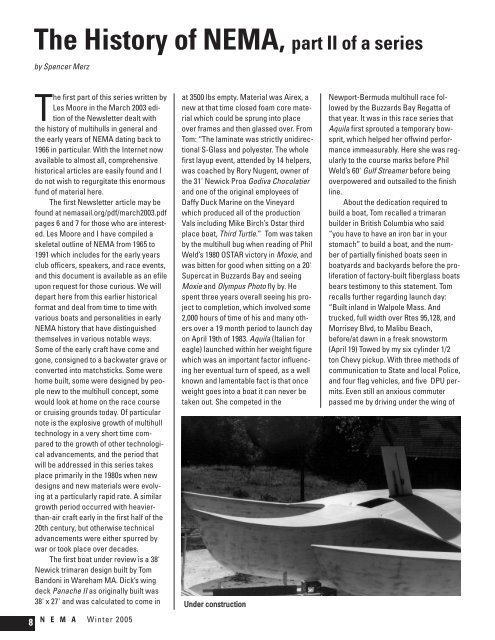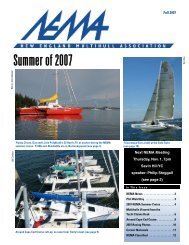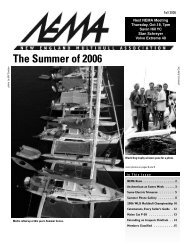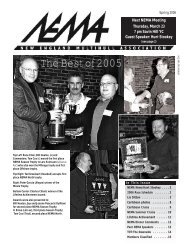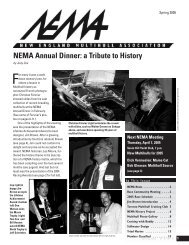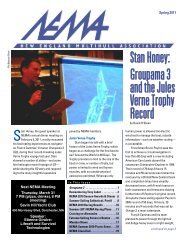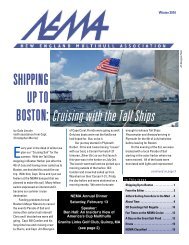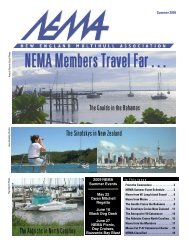Winter 2005 - New England Multihull Association
Winter 2005 - New England Multihull Association
Winter 2005 - New England Multihull Association
Create successful ePaper yourself
Turn your PDF publications into a flip-book with our unique Google optimized e-Paper software.
The History of NEMA, part II of a series<br />
by Spencer Merz<br />
8<br />
The first part of this series written by<br />
Les Moore in the March 2003 edition<br />
of the <strong>New</strong>sletter dealt with<br />
the history of multihulls in general and<br />
the early years of NEMA dating back to<br />
1966 in particular. With the Internet now<br />
available to almost all, comprehensive<br />
historical articles are easily found and I<br />
do not wish to regurgitate this enormous<br />
fund of material here.<br />
The first <strong>New</strong>sletter article may be<br />
found at nemasail.org/pdf/march2003.pdf<br />
pages 6 and 7 for those who are interested.<br />
Les Moore and I have compiled a<br />
skeletal outline of NEMA from 1965 to<br />
1991 which includes for the early years<br />
club officers, speakers, and race events,<br />
and this document is available as an efile<br />
upon request for those curious. We will<br />
depart here from this earlier historical<br />
format and deal from time to time with<br />
various boats and personalities in early<br />
NEMA history that have distinguished<br />
themselves in various notable ways.<br />
Some of the early craft have come and<br />
gone, consigned to a backwater grave or<br />
converted into matchsticks. Some were<br />
home built, some were designed by people<br />
new to the multihull concept, some<br />
would look at home on the race course<br />
or cruising grounds today. Of particular<br />
note is the explosive growth of multihull<br />
technology in a very short time compared<br />
to the growth of other technological<br />
advancements, and the period that<br />
will be addressed in this series takes<br />
place primarily in the 1980s when new<br />
designs and new materials were evolving<br />
at a particularly rapid rate. A similar<br />
growth period occurred with heavierthan-air<br />
craft early in the first half of the<br />
20th century, but otherwise technical<br />
advancements were either spurred by<br />
war or took place over decades.<br />
The first boat under review is a 38'<br />
<strong>New</strong>ick trimaran design built by Tom<br />
Bandoni in Wareham MA. Dick’s wing<br />
deck Panache II as originally built was<br />
38' x 27' and was calculated to come in<br />
N E M A <strong>Winter</strong> <strong>2005</strong><br />
at 3500 lbs empty. Material was Airex, a<br />
new at that time closed foam core material<br />
which could be sprung into place<br />
over frames and then glassed over. From<br />
Tom: “The laminate was strictly unidirectional<br />
S-Glass and polyester. The whole<br />
first layup event, attended by 14 helpers,<br />
was coached by Rory Nugent, owner of<br />
the 31' <strong>New</strong>ick Proa Godiva Chocolatier<br />
and one of the original employees of<br />
Daffy Duck Marine on the Vineyard<br />
which produced all of the production<br />
Vals including Mike Birch’s Ostar third<br />
place boat, Third Turtle.” Tom was taken<br />
by the multihull bug when reading of Phil<br />
Weld’s 1980 OSTAR victory in Moxie, and<br />
was bitten for good when sitting on a 20'<br />
Supercat in Buzzards Bay and seeing<br />
Moxie and Olympus Photo fly by. He<br />
spent three years overall seeing his project<br />
to completion, which involved some<br />
2,000 hours of time of his and many others<br />
over a 19 month period to launch day<br />
on April 19th of 1983. Aquila (Italian for<br />
eagle) launched within her weight figure<br />
which was an important factor influencing<br />
her eventual turn of speed, as a well<br />
known and lamentable fact is that once<br />
weight goes into a boat it can never be<br />
taken out. She competed in the<br />
Under construction<br />
<strong>New</strong>port-Bermuda multihull race followed<br />
by the Buzzards Bay Regatta of<br />
that year. It was in this race series that<br />
Aquila first sprouted a temporary bowsprit,<br />
which helped her offwind performance<br />
immeasurably. Here she was regularly<br />
to the course marks before Phil<br />
Weld’s 60' Gulf Streamer before being<br />
overpowered and outsailed to the finish<br />
line.<br />
About the dedication required to<br />
build a boat, Tom recalled a trimaran<br />
builder in British Columbia who said<br />
“you have to have an iron bar in your<br />
stomach” to build a boat, and the number<br />
of partially finished boats seen in<br />
boatyards and backyards before the proliferation<br />
of factory-built fiberglass boats<br />
bears testimony to this statement. Tom<br />
recalls further regarding launch day:<br />
“Built inland in Walpole Mass. And<br />
trucked, full width over Rtes 95,128, and<br />
Morrisey Blvd, to Malibu Beach,<br />
before/at dawn in a freak snowstorm<br />
(April 19) Towed by my six cylinder 1/2<br />
ton Chevy pickup. With three methods of<br />
communication to State and local Police,<br />
and four flag vehicles, and five DPU permits.<br />
Even still an anxious commuter<br />
passed me by driving under the wing of


